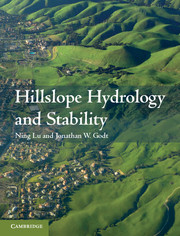Book contents
- Frontmatter
- Contents
- Foreword
- Preface
- List of Symbols
- PART I Introduction and state of the art
- 1 Introduction
- 2 Hillslope geomorphology
- PART II Hillslope hydrology
- Part III Total and effective stress in Hillslopes
- PART IV Hillslope Material properties
- PART V Hillslope stability
- References
- Index
- Plate section
1 - Introduction
from PART I - Introduction and state of the art
Published online by Cambridge University Press: 05 February 2013
- Frontmatter
- Contents
- Foreword
- Preface
- List of Symbols
- PART I Introduction and state of the art
- 1 Introduction
- 2 Hillslope geomorphology
- PART II Hillslope hydrology
- Part III Total and effective stress in Hillslopes
- PART IV Hillslope Material properties
- PART V Hillslope stability
- References
- Index
- Plate section
Summary
Landslide overview
Landslides are one of the most widespread and effective agents in sculpting the earth's surface (Eckel, 1958, p.1). They are ubiquitous in mountainous and hilly environments in all parts of the world and are an important mechanism for moving earth materials from uplands to river systems. The general term “landslide” is used to describe a wide range of gravity-driven mass movements both on the land surface and beneath bodies of water. Landslides include diverse slope movements such as rock fall and debris flows, which are described in more detail in Section 1.2.
Landslides are the failure of sloping earth materials. A hillslope fails when forces or stresses acting upon it overcome the strength of the earth materials. Some of the forces acting on a hillslope include gravity, pore-water pressure, tectonic uplift, and earthquake shaking. These forces act over time scales ranging from geologic to essentially instantaneous and over spatial scales that range from continental to the soil grain. The strength of hillslope materials is a function of geologic composition and stress state, and is modified by past movement, weathering, vegetation, and hydrologic processes. These concepts are discussed in detail in Chapters 3, 4, 5, 6, 7, and 8.
- Type
- Chapter
- Information
- Hillslope Hydrology and Stability , pp. 3 - 26Publisher: Cambridge University PressPrint publication year: 2013



